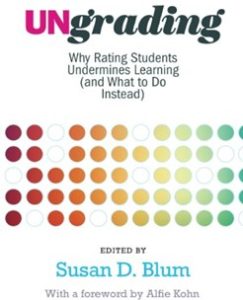Discussion 3 – Practices
UNgrading – Why Rating Students Undermines Learning (and What to Do Instead)
2025 Spring Scholarship of Teaching & Learning Book Discussion Series

In UNgrading, fifteen educators write about their diverse experiences going gradeless. Some contributors are new to the practice, and some have been engaging in it for decades. Some are in humanities and social sciences, some in STEM fields. Some are in higher education, but some are the K–12 pioneers who led the way.
Based on rigorous and replicated research, this book shows why and how faculty who wish to focus on learning, rather than sorting or judging, might proceed. It includes honest reflection on what makes ungrading challenging, and testimonials about what makes it transformative.
Discussion 3 – Practices (pages 91 – 170) (March 7, 2025)
Discussion facilitated by Julie Mendez
- No one model of alternative grading works for all contexts
- What might work in a writing course probably won’t make sense for a math course
- One major component of alternative grading is having clearly defined standards for what is acceptable student work.
- See Finding common ground with grading systems from the Grading for Growth blog
- Grading and providing substantive feedback takes so much time
- Feedback is critical from a growth mindset perspective
- Consider focusing on/assessing the most important skills (e.g., don’t correct grammar)
- Consider providing video feedback rather than written feedback
- Can AI help by reviewing writing assignments?
- Do students even read or absorb feedback?
- Do students understand that taking off points is feedback in itself?
- How to differentiate what students want to learn/are interested in learning vs. what students are supposed to learn and know
- o Allow freedom to make mistakes without penalty
- o Perfectionism increases stress for students and faculty
- Focus on “what students are doing to learn” rather than “how they are doing”
- Reflection is a critical element of metacognition and encourages students to think about their learning
- Highlights the knowledge and skills learned
- Acknowledges the learning process and learning strategies
Key Takeaways
- Start slow – seek student buy-in and feedback
- Provide more feedback going forward
- Peer feedback and sharing is different from faculty feedback
- Can be casual face-to-face feedback that is co-created by students and not purely faculty-led
- Disrupts typical power dynamics and hierarchy
- Consider what worked well and what you would do differently
- Seek student feedback on their preferred style of faculty feedback
- Do-review-redo shows effort and progress and reduces conflicts over points
